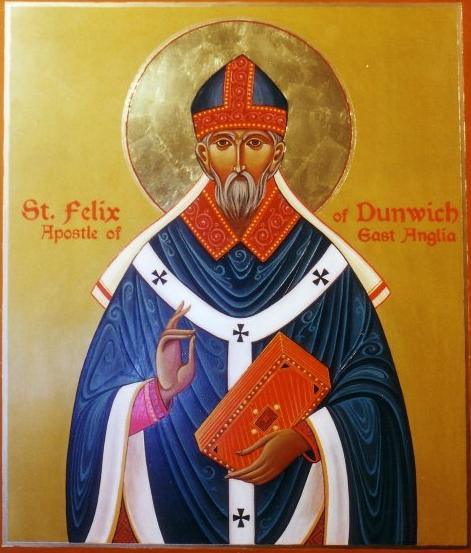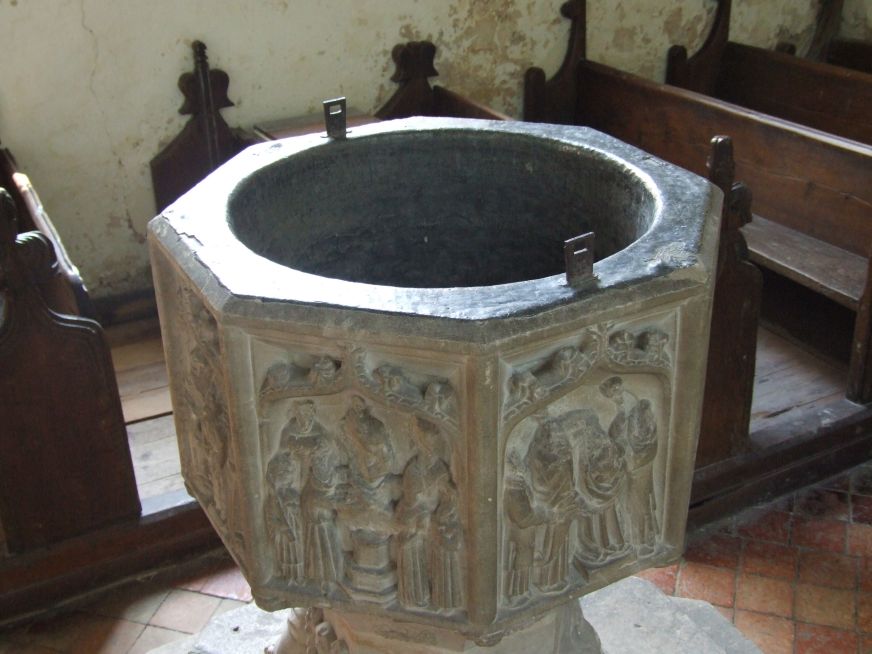(† 647)

| Orthodox Outlet for Dogmatic Enquiries | Biographies |
|---|
|
Saint Felix
of Dunwich, Apostle and first bishop of East Anglia
(aka Saint
Felix of Burgundy)
(† 647) |
 |
A first approach to the indigenous Orthodox Saints and Martyrs of the Ancient Church who lived and who propagated the Faith in the British Isles and Ireland during the first millennium of Christianity and prior to the Great Schism is being attempted in our website in our desire to inform our readers, who may not be aware of the history, the labours or the martyrdom of this host of Orthodox Saints of the original One, Holy, Catholic and Apostolic Church of our Lord.
"The Church in The British Isles will only begin to grow when she begins to venerate her own Saints" (Saint Arsenios of Paros †1877)
|
SAINT FELIX (meaning happy or joyful) came to East Anglia from Burgundian territory (probably from one of the monastic houses founded by the Irish missionary, St. Columnbanus) in the company of Sigbert (Sigeberht) the Learned, whom he had converted to Christianity (while Felix was still in seminary). Sigbert would later become an East Anglian King. (In the eighth century a number of the English, most famously Boniface and Willibrord, would return to the continent to convert the heathen on the mainland.) Felix is renowned as a great missionary and became the first Bishop of the East Angles. He is said to have founded a monastery at Soham about A.D. 630. Felix, having been consecrated about 631 A.D. by St. Honorius, held the first bishopric of the East Angles at Dommoc (Dunwich) for seventeen years. St. Honorius (c.630-653), was the fourth archbishop of Canterbury in line from St Augustine who had brought Christianity from Rome to King AEthelberht of Kent in 597. Honorius sent Felix on to East Anglia, which had switched between Christianity and paganism several times since the East Anglian king Raedwald became a Christian at the Kentish court in the first decade or so of the seventh century. (Bede tells the story that when Rædwald got home, his wife convinced him not to abandon his old gods so easily, so Raedwald had shrines to his heathen gods and the Christian god in the same temple.) Raedwald's son Eorpwald succeeded sometime after 616, initially as a pagan but he was converted by the Northumbrian king Edwin sometime around 630. Shortly after Eorpwald became Christian, he was killed, and the country turned pagan again. It was after Eorpwald's reign that Eorpwald's brother Sigeberht came to the throne. Sigeberht had grown up in exile in Gaul, and become a Christian there, and returned determined to turn East Anglia into a thoroughly Christian kingdom. According to legend, Felix landed at what is now Felixstowe before going on to establish a Cathedral and school at Dommoc, or Dummoc-ceastre, generally accepted as Dunwich, a seaport on the coast of Suffolk. Dummoc had been a Roman station and, besides the advantage of its port, its walls may still have been strong enough to afford some protection for the new Bishop. It was, moreover, connected with the interior by ancient roads, which led in one direction toward Bury St. Edmunds and in another toward Norwich. At Dummoc, King Sigebert built a palace for himself and a church for Felix. Elsewhere, says Bede, "desiring to imitate those things which he had seen well arranged in Gaul, he founded a school in which boys might be taught letters, with the aid of Felix, the bishop....who furnished them with pedagogues and masters, after the Kentish fashion." Bede gives no locality for this school; yet the passage, without the slightest reason, has been looked upon as recording the foundation of the University of Cambridge, a place which, at that period, was not even within the borders of East Anglia. Four years after the establishment of the see, the King resigned his crown in favour of his cousin, Egric, and retired to a monastery which he had founded with the Irish monk, Fursey, at Burgh Castle. Felix founded a third monastery at Soham and it was here that he died, on 8th March AD 647, and was buried. His relics were later translated to Ramsey Abbey (Hunts). From Dommoc (Dunwich) Felix set about missionary throughout East Anglia, establishing churches and founding the monastery at Bury St Edmunds (images of the monastery ruins and a drawing of the reconstructed Abbey of St Edmund, dated AD1450, below).
In 630 he founded another monastery, this time at Soham (below).
 Ancient baptismal font in Soham Abbey
Ancient baptismal font in Soham Abbey
Bede records the success of Felix's work in East Anglia, known for his great piety and hard work, as both a missionary and educator, Felix, in Bede's words "delivered" East Anglia from long-standing unrighteousness and unhappiness. As a pious cultivator of the spirited field, he found abundant faith in a believing people. In no part of England was Christianity more favourably introduced". According to the chronicler of the times the episcopate of Felix was full of happiness for the cause of Christianity and the admirable historian, Bede, described his work with an allusion to the good omen of his name. Bede wrote that St. Felix "delivered all the province of East Anglia from long-standing unrighteousness and unhappiness. As a pious cultivator of the spirited field, he found abundant faith in a believing people. In no part of England was Christianity more favourably introduced". Bede continues: "He (St. Felix) did not fail in his purpose and like a good farmer reaped a rich harvest of believers. He delivered the entire province from its age-old wickedness and infelicity and brought it to the Christian faith and works of righteousness, and in full accord with the significance of his own name, guided it towards eternal felicity". By his presence at Soham all those decades ago the town can take pride in its former importance as a renowned Christian centre. The great evangelist and educator died on March 8th, 647 A.D. and he was buried in his own city of Dunwich. He is commemorated in the seaside town of Felix-stowe and also of a Yorkshire village, Felis-kirk (the church of Felix). The mortal remains of St. Felix were later exhumed from Dunwich and brought to Soham monastery which he had founded. This was a precautionary measure for fear that heathen flames would take possession of them. In King Canute's time, about 1031 A.D. the relic was removed a second time for the same reason by a monk named Etheric to Ramsey in Huntingdonshire, and there solemnly enshrined by Abbot Ethelstan. While the relic was being carried across the water a miracle is said to have happened. A chronicler at Soham or Ramsey wrote:
He is commemorated in both the Anglican and Orthodox traditions, with an Orthodox Church dedicated jointly to him and St Edmund in Felixstowe. --------------------------
|
Article published in English on: 20-3-2011.
Last update: 20-3-2011.